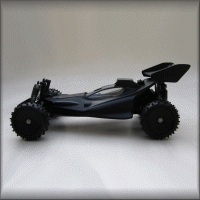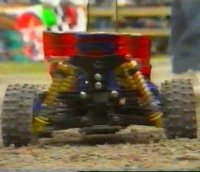TOPIC:
Notes on Tamiya RC Evolution 12 years 6 months ago #3251
|
I was curious about how Tamiya RC cars have evolved so did a little research – and just about everything we take for granted on a modern RC car was already in place by 1981.
Caveats: this is not an exhaustive list of features – just the things I noticed (so feel free to chime in – I’m interested when BEC features were first available, and the first “proper” ESC), it also doesn’t say how well a particular feature worked. “Firsts” are for Tamiya – not necessarily for RC cars in general. It’s also surprisingly short, materials may have changed for the better, and the number of features per car have certainly improved, but fundamentally, 82 of the cars in the first 100 had no new features whatsoever – and I had to struggle to get the number as low as that. Take the Avante for instance, normally considered as a technological tour de force; and if you don’t think these are features, take a look at the early cars from any manufacturer, and the “round the pole” racers that were the precursor to radio control cars: 2-channel radio control – first seen 1977 (58001 Porsche 934) Lightweight flat chassis parts - first seen 1977 (58001 Porsche 934) Servo saver – first seen 1977 (58004 XR311 Combat Support Vehicle) Sealed gearbox – first seen 1977 (58004 XR311 Combat Support Vehicle) Semi Pneumatic tyres – first seen 1977 (58004 XR311 Combat Support Vehicle) Double wishbone suspension – first seen 1977 (58004 XR311 Combat Support Vehicle) 7.2v Ni-Cads – Ni-Cads first seen 1977 (58002 Martini Porsche 935 Turbo), first 7.2v pack seen 1979 (58015 Rough Rider) Oil Dampers – first seen 1979 (58015 Rough Rider) Suspension adjustable up the wazzoo – first seen 1980 (58021 Can-Am Lola) Polycarbonate body – first seen 1980 (58021 Can-Am Lola) Technigold motor – first non silvercan motor seen 1980 (58021 Can-Am Lola) Four Wheel drive – first seen 1981 (58028 Toyota 4x4 Pickup) In fact, the only new features on the Avante were the centre differential, and the “midship” mounted motor – and the motor placement is a bit of a stretch IMO. 58001 Porsche 934 (1976) First Tamiya RC car. Fundamentally the bodywork from Tamiya’s 1/12th scale kit, mounted on a pressed metal chassis. Powered by D-cell batteries, it features a differential, and the mechanical speed control, used only on this model, is practically a work of art. 58002 Martini Porsche 935 Turbo (1977) First Tamiya RC capable of taking Ni-Cad rechargeable batteries (a hard cased, 6v pack with 5 sub C cells) 58004 XR311 Combat Support Vehicle (1977) First Tamiya off-roader, with semi pneumatic tyres, double wishbone suspension all round, steering servo saver, and a sealed gearbox with 3 choices of gear ratio. 58015 Rough Rider (1979) First Tamiya car with dampers, and the first to accommodate a 7.2v battery – a hard cased, 6 cell “hump” pack. Also features a waterproof mechanism box. 58021 Can-Am Lola (1980) First polycarbonate body, also feature adjustable front suspension geometry – castor/camber, toe-in/out, steering angle & Ackerman angle. First car to use a motor other than a silvercan 360, 380 or 540 – the RS540SD Black Motor Sprint. 58023 Holiday Buggy (1980) First moulded plastic “bathtub” chassis, first (and only) polyethylene body. 58028 Toyota 4x4 Pickup (1981) First 4-wheel drive car, very scale looking ladder chassis, suspension & cast axles, a transistorised speed controller, first (factory assembled) 3-speed transmission that could be switched on the move (4 channel, 3 servo radio set required), and took a high capacity battery – 4000mAH. 58034 Super Champ (1982) Monoshock back end, with a remote oil reservoir. 58035 Wild Willy M38 (1982) First Tamiya car designed to wheelie. 58036 Audi Quattro Rally (1983) First hybrid body – mostly polycarbonate for lightness, but with injection moulded front and rear panels for detail. 58038 Subaru Brat (1983) First “truggy” – pickup truck body on a buggy chassis – although the phrase itself wouldn’t be invented for another 20 years. First injection moulded space frame chassis. 58043 Grasshopper (1984) First appearance of the rolling rigid rear axle/gearbox. 58047 Hotshot (1985) First four wheel drive buggy 58057 Bigwig (1986) First car to use an 8.4v, 7 cell battery. 58058 Blackfoot (1986) First “monster” truck 58059 Porsche 959 (1986) First “blow moulded” polycarbonate body. 58065 Clodbuster (1987) First twin-motor vehicle, first with four wheel steering. 58072 Avante (1988) First 4-wheel drive buggy with a centre differential, and a “midship” mounted motor. |
|
Please Log in to join the conversation.
Last edit: by larbut.
|
Re: Notes on Tamiya RC Evolution 12 years 6 months ago #3271
|
Very interesting reading!
After a quick glance on the list, maybe the Can Am Lola deserves the title "Most innovative vintage Tamiya" ? -Lars Signature now gets correct formatting if you edit it in your Profile. Use normal BBcode if you want.
www.tamiyabase.com was formatted automatically. |
|
|
Please Log in to join the conversation. |
Re: Notes on Tamiya RC Evolution 12 years 6 months ago #3277
|
It's certainly up there, personally I'd probably say the XR311 is #1 for innovation, with the first 3 speed at #2 & the Lola at #3 ... You could make a case that there was no real development of RC chassis after 1981, with nothing much happening for 25 years, then in the last few years the electrical/electronic side of things has been developed (2.4ghz radios, affordable ESCs, Lipo batteries & brushless motors) |
|
Please Log in to join the conversation. |
Re: Notes on Tamiya RC Evolution 12 years 6 months ago #3279
|
Not a Tamiya product, so I know this is not what you're looking for, but could be interesting for some, anyway
The first "proper" ESC custom made for a Tamiya car must be the Acoms AP-35 for the SRB, designed and produced for Acoms by the (at the time) UK Tamiya/Acoms distributor RiKo in 1982. Why I say it was custom made for the SRB? Because it was sized to fit in the SRB radio box, the Darlington power transistor was wired and would replace the SRB MSC resistor, for cooling. The instruction sheet also includes directions for fitting in a SRB. At the same time there was a ESC named KO Digiace that was popular, but it was more of a generic ESC. Tom
The following user(s) Liked this: Jonny Retro
|
|
|
Please Log in to join the conversation. |
Time to create page: 0.100 seconds




